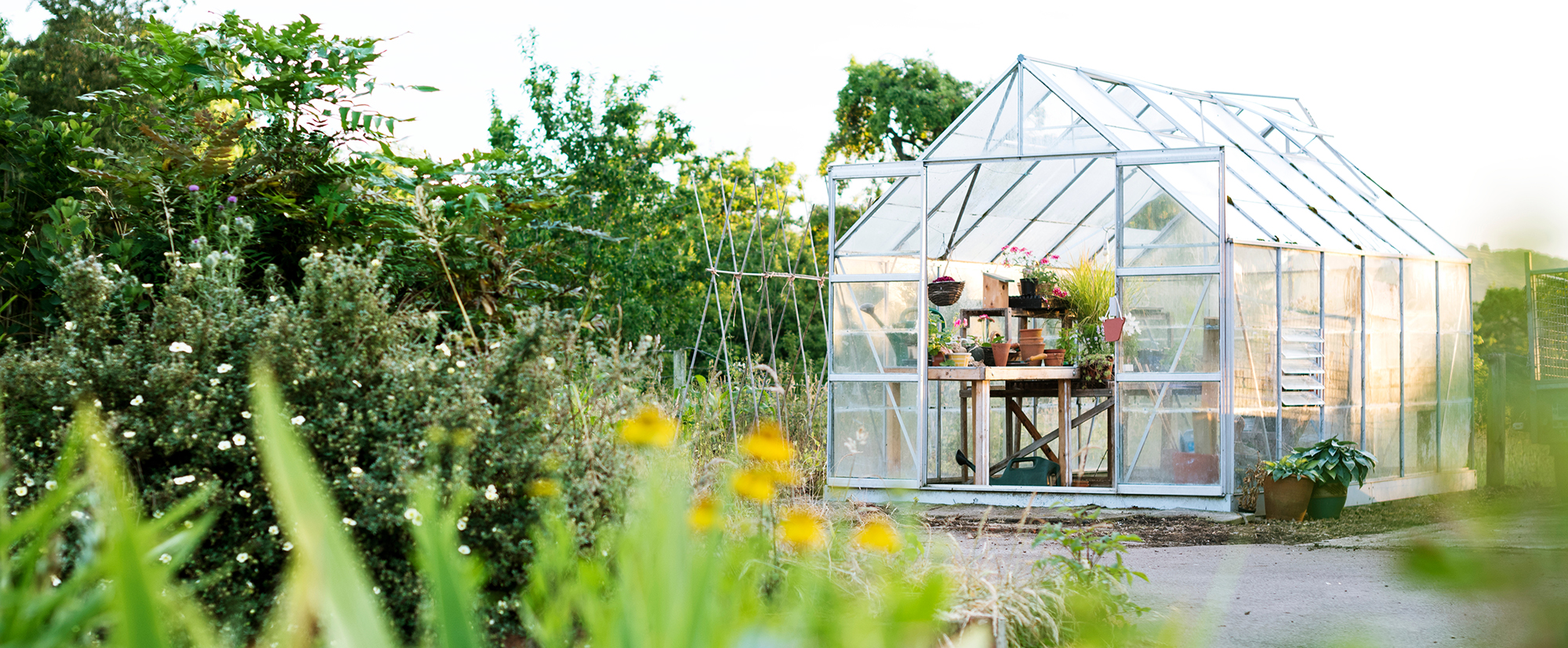FREE delivery in the contiguous US!

A greenhouse provides a wealth of benefits for your home. They extend your growing season through the winter and prevent pests from destroying your plants. Plus, you can grow plants that aren’t native to your area. With time and the right resources, you’ll have a beautiful greenhouse in the comfort of your backyard. Read below for tips on how to build your very own DIY greenhouse.
How to Build a Greenhouse
Follow these general guidelines when building a backyard greenhouse:
1 – Choose Your Location
Sun exposure is arguably the most important factor for your greenhouse. You want to erect your greenhouse on the south side of your home in a spot that gets the most sunlight from fall through winter. If this isn’t feasible, your next best option is the southeast or east sides, followed by the west or southwest. The least desirable location is the north side of your home.

2 – Consider Afternoon Shade
Depending on the types of plants you want to grow, your greenhouse may benefit from afternoon shade. Consider situating your greenhouse near deciduous trees — trees that shed their leaves seasonally. In the summer, these trees shelter your greenhouse when the blistering heat reaches its peak. During winter, their leaves will fall and give your greenhouse the extra sunlight it needs. Don’t have these trees in your backyard? Put it on your to-do list and plant them!

3 – Decide on a Freestanding or Attached Greenhouse
A freestanding greenhouse gives you flexibility in terms of size, placement, and expandability. On the other hand, a greenhouse attached to your home requires fewer materials and provides easy access to your home’s heating, electricity, and water. Think about the factors that are important to you, and decide which type of greenhouse brings you and your family the most enjoyment.

4 – Pick the Right Size for Your Needs
A good rule of thumb to follow is one square foot of space for every six-inch pot as far as size goes. Also, make sure your greenhouse is at least 25% bigger than you think you’ll need because plant collections usually get bigger, not smaller!
You’ll also need to consider how big your pathways are going to be. If you’re the only one managing your greenhouse, you want to allow at least 19 inches for your paths. If you’re bringing in visitors or equipment, allow at least 24 inches of space.

5 – Choose Your Building Materials
Glass, polycarbonate, and acrylic are the three premium materials that can make your greenhouse durable, functional, and beautiful. Here’s a quick rundown of each one:
- Glass — Glass is the classic choice due to its sustainability and beauty. It also offers the best longevity with an average 25-year lifespan. The downside is that it’s heavy, so it requires the sturdiest framework. Also, inclement weather can easily damage your glass.
- Polycarbonate — Polycarbonate is a lighter option with higher impact resistance than glass, but it only has about a lifespan of 7–12 years. Additionally, this material will yellow over time.
- Acrylic — Acrylic is a naturally UV-resistant material providing the highest light transmission of all three materials. Also, acrylic won’t yellow over its average lifespan of 15–20 years. However, acrylic is susceptible to inclement weather like glass and more brittle than polycarbonate.
6 – Heating & Ventilation
If you’re planning to grow your plants in the winter, you’ll need heat in your greenhouse. Roughly 25% of your heat comes from the sun, so you’ll need another heat source to cover the rest of your greenhouse. Oil, gas, and electricity are common sources that can be delivered via forced air, steam, and radiant heating. For more eco-friendly options, you can use compost and passive solar energy.

When summer hits, ventilation is essential to keep your plants happy and healthy. The easiest option is a fan. If you go this route, you’ll need to cycle the air about once per minute. For the most luxury, consider installing automatic vent openers to help circulate air.
7 – Other Considerations
Once you have a plan for your greenhouse, take a moment to consider the following:
- DIY or Professional Help — Do you want the satisfaction of building a greenhouse yourself, or do you want to play it safe and hire your preferred contractor?
- Good Drainage — Build your greenhouse on a level area with well-draining ground. Avoid constructing it on a slope that collects cold air and is prone to frost.
- Storm Damage — Position your greenhouse in a spot that’s as protected from severe winds as possible. You may want to plant hedges or fencing around your greenhouse for further protection.

Conclusion
A backyard greenhouse is an excellent way to get you and your family outdoors. Whether you’re growing veggies, fruits, herbs, flowers, or everything in between, you’ll be able to enjoy the thrill of gardening all year long.
